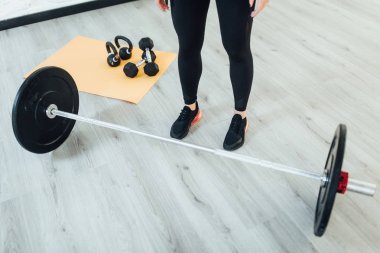
How To Start A Workout Routine (11 Helpful Guidelines)
How to start a workout routine: Begin by setting clear goals tailored to your fitness level and objectives. Incorporate a variety of exercises to keep your routine engaging and effective. Embarking on a journey to start a workout routine is akin to taking that first exhilarating step onto an uncharted path toward vitality and strength. It’s a pledge to oneself, a promise of transformation, and a commitment to embrace the symphony of motion that your bodies crave.
But where does one begin amidst the cacophony of fitness trends and conflicting advice? Fear not, for in this labyrinth of possibilities, there exists a beacon of clarity, guiding you towards the threshold of a new beginning. So, let’s embark together, navigating the terrain of motivation, technique, and perseverance, to unravel the art of commencing a workout routine that not only ignites the flames of passion but also fosters a harmonious relationship with your physical selves.
Embarking on a workout routine can be both exhilarating and daunting. However, with the right approach, you can kickstart your journey to a healthier lifestyle and improved fitness levels. Here’s a comprehensive guide on how to initiate your workout routine successfully.

How To Start A Workout Routine
Starting a workout routine involves setting goals, choosing activities you enjoy, creating a schedule, and gradually increasing intensity.
Setting Goals:
Begin by defining clear and achievable goals that align with your fitness aspirations. Whether it’s losing weight, building muscle, or enhancing overall well-being, having specific objectives will keep you motivated and focused.
Choosing Activities:
Explore various physical activities and exercises to find ones that resonate with you. From jogging and cycling to yoga and weightlifting, there’s a myriad of options to cater to different preferences and fitness levels.
Creating a Schedule:
Establish a consistent workout schedule that fits into your daily routine. Whether it’s early morning sessions before work or evening workouts after dinner, find a time that works best for you and stick to it.
Gradually Increasing Intensity:
Start with manageable intensity and duration, then progressively challenge yourself as you build strength and endurance. Avoid pushing too hard initially to prevent burnout or injuries, and listen to your body’s cues along the way.
Assess Your Current Fitness Level
Physical Assessment
Physical assessment is a crucial component of healthcare, providing invaluable insights into an individual’s overall health status. Among the key metrics evaluated during a physical assessment are body weight and Body Mass Index (BMI). Body weight serves as a fundamental indicator of general health and can highlight changes that may signify underlying conditions.
BMI, calculated from weight and height measurements, offers a standardized measure to assess body composition and identify potential risks associated with weight-related health issues such as obesity or undernourishment. By incorporating these measurements into a comprehensive physical assessment, healthcare professionals can tailor interventions and support to promote optimal health and well-being for their patients.
Health Assessment
Health assessment is a fundamental process in healthcare aimed at evaluating an individual’s overall health status and identifying potential risk factors or health concerns. It involves a comprehensive review of a person’s medical history, lifestyle factors, and current symptoms or complaints. Health assessment typically encompasses physical examinations, laboratory tests, and screening procedures to gather data on vital signs, organ function, and disease markers.
Through careful observation and analysis, healthcare professionals can gain insight into a person’s health status, enabling them to develop personalized care plans, provide preventive interventions, and facilitate early detection and treatment of illnesses. A thorough health assessment not only serves as a basis for clinical decision-making but also fosters patient-provider communication and empowers individuals to actively engage in their own healthcare management.
Goal Setting
Goal setting in workout routine is paramount for progress and success. By establishing clear and realistic objectives, individuals can effectively chart their fitness journey and stay motivated along the way. Whether aiming to lose weight, build muscle, improve endurance, or enhance overall health, setting specific, measurable, attainable, relevant, and time-bound (SMART) goals is essential.
Breaking down long-term goals into smaller milestones not only makes them more manageable but also allows for regular evaluation and adjustment. Additionally, setting goals that resonate with personal values and priorities increases commitment and determination. Ultimately, goal setting in fitness serves as a roadmap, guiding individuals towards their desired outcomes and empowering them to lead healthier, more fulfilling lives.
Choose Your Workout Activities
Explore Different Options
Exploring various options in a workout routine can invigorate both the body and mind, ensuring holistic fitness progress. From high-intensity interval training (HIIT) to yoga, weightlifting to dance classes, the plethora of options caters to diverse preferences and goals. Engaging in different activities not only prevents monotony but also targets various muscle groups, promoting balanced strength and flexibility.
Additionally, experimenting with new workouts challenges the body in novel ways, fostering adaptation and continual improvement. Whether it’s outdoor activities like hiking and cycling or indoor sessions like Pilates and martial arts, the exploration of different options adds excitement and vitality to the fitness journey, fostering a lifelong commitment to health and wellness.
Create Variety
Introducing variety into your workout routine is essential for maximizing results and preventing plateaus. Incorporating different exercises, such as strength training, cardio, flexibility, and balance exercises, challenges your body in new ways and keeps your muscles guessing. Switching up your routine not only targets different muscle groups but also adds excitement and motivation to your workouts.
You can explore various workout modalities like HIIT, yoga, Pilates, or even outdoor activities like hiking or swimming to keep things interesting. By embracing variety, you not only enhance your physical fitness but also cultivate a more well-rounded and enjoyable approach to staying active.

Start Slow
Starting slow in a workout routine is not just a recommendation; it’s a foundational principle for long-term success and injury prevention. Rushing into intense workouts without proper conditioning can lead to burnout, injuries, and discouragement. By easing into a workout regimen, individuals allow their bodies to adapt gradually, building strength, endurance, and flexibility over time.
Starting with light exercises or shorter durations allows muscles, joints, and cardiovascular systems to acclimate to increased physical activity. Moreover, beginning slowly fosters a sustainable habit, as it’s more manageable to maintain consistency when the demands are reasonable. Embracing a gradual approach sets the stage for progress, ensuring that fitness journeys are both effective and enjoyable in the long run.
Set Up Your Workout Space
Determine Your Preferred Environment
When crafting your workout routine, it’s crucial to consider your preferred environment as it can significantly impact your motivation and enjoyment. Some thrive in the bustling energy of a gym, feeding off the collective drive and camaraderie. For them, the clanging of weights and the hum of cardio machines serve as a symphony of motivation.
Others find solace in the tranquility of outdoor settings, relishing the fresh air and natural surroundings as they push their bodies to new limits. Whether you prefer the structured setting of a fitness center or the freedom of outdoor spaces, aligning your workout environment with your preferences can enhance your consistency and overall satisfaction with your fitness journey.
Gather Necessary Equipment
In any workout routine, gathering the necessary equipment is paramount to ensure a productive and safe exercise session. From resistance bands to free weights, yoga mats to heart rate monitors, each piece of equipment serves a specific purpose in enhancing the effectiveness of workouts and minimizing the risk of injury.
Prior to beginning any exercise regimen, it’s essential to assess the type of workouts planned and acquire the corresponding equipment accordingly. Whether it’s for strength training, cardiovascular exercises, or flexibility routines, having the right tools on hand can significantly elevate the quality of each workout session, facilitating progress towards fitness goals and overall well-being.

Create a Dedicated Space
Incorporating a dedicated space into your workout routine can significantly enhance your exercise experience. Whether it’s a corner in your living room or a section of your backyard, having a designated area for physical activity helps establish a consistent habit and mindset for fitness. This space serves as a tangible reminder of your commitment to health and wellness, eliminating the need to scramble for a suitable spot each time you exercise.
Additionally, a designated workout area can be personalized to cater to your specific needs, equipped with essential gear and tools to support your fitness goals. By creating this dedicated space, you cultivate an environment conducive to focus, motivation, and productivity, ultimately empowering you to maximize your workout sessions and achieve optimal results.
Develop a Consistent Schedule
Determine Frequency
Determining frequency in a workout routine is crucial for achieving fitness goals effectively. It involves striking the right balance between exercising enough to stimulate progress and allowing sufficient time for recovery. Frequency varies based on factors like fitness level, goals, and types of exercises. Beginners might benefit from three to four workouts per week to gradually build strength and endurance while allowing recovery.
Intermediate and advanced individuals may increase frequency to five or six times a week, incorporating varied intensities and types of workouts. However, it’s essential to listen to your body, adjusting frequency as needed to prevent burnout or injury. A well-structured workout routine with optimal frequency ensures steady progress towards improved health and fitness.
Establish Routine
Establishing a routine in your workout regimen is key to achieving consistent progress and maintaining motivation. By setting specific times each day or week for exercise, you create a structure that makes it easier to prioritize physical activity amidst the demands of daily life. Consistency breeds results, as regular exercise not only improves physical health but also enhances mental well-being.
Whether it’s hitting the gym before work, going for a run in the evening, or practicing yoga at sunrise, finding a routine that fits your schedule and preferences is essential. Over time, sticking to this routine becomes habitual, making it easier to stay committed to your fitness goals and reap the benefits of a healthier lifestyle.
Be Flexible
Being flexible in your workout routine is crucial for progress and overall well-being. While consistency is important, so is adaptation. By incorporating variety into your workouts, such as trying different exercises, changing up your intensity, or exploring various fitness classes, you not only keep things interesting but also challenge your body in new ways.
Moreover, being open to adjusting your routine based on your energy levels, schedule, or any physical limitations ensures that you can maintain a sustainable and enjoyable fitness regimen. Flexibility allows you to listen to your body and make adjustments as needed, ultimately leading to better results and a healthier mindset towards exercise.
Warm Up and Cool Down Properly
Warm-Up
In any effective workout routine, warming up is crucial for preparing the body and mind for physical activity. A proper warm-up session gradually increases heart rate, improves blood circulation, and loosens muscles and joints, reducing the risk of injury during more intense exercise. It also mentally primes the individual, enhancing focus and motivation for the workout ahead.
Incorporating dynamic movements such as jogging, jumping jacks, or arm circles, along with stretching exercises targeting major muscle groups, helps to increase flexibility and range of motion. Additionally, a warm-up period allows time to mentally transition from daily tasks to the upcoming workout, setting the tone for a productive and safe training session.
Cool Down
Cooling down is an essential part of any workout routine, acting as the gentle transition from intense physical activity back to a state of rest. This phase allows the body to gradually lower its heart rate, regulate blood flow, and return breathing to a normal pace. Incorporating stretches during the cool down helps to lengthen muscles that may have tightened during exercise, reducing the risk of injury and promoting flexibility.
Moreover, it aids in preventing post-workout muscle soreness by flushing out lactic acid buildup. Beyond the physical benefits, the cool down also provides a mental space for reflection and relaxation, allowing the mind to unwind and appreciate the effort put into the workout. Overall, including a proper cool down in your exercise routine is crucial for both physical recovery and mental well-being.

Monitor Your Progress
Track Your Workouts
Tracking your workouts in your routine is essential for progress and consistency. Whether you’re a beginner or a seasoned fitness enthusiast, keeping a record of your exercises, sets, reps, and weights allows you to monitor your improvements over time and make necessary adjustments to your routine. By tracking your workouts, you gain valuable insights into your strengths and weaknesses, enabling you to tailor your training program to meet your specific goals effectively.
Additionally, tracking your workouts fosters accountability and motivation, as you can visually see your accomplishments and stay committed to your fitness journey. Whether it’s through a smartphone app, a notebook, or a spreadsheet, taking the time to document your workouts ensures that you stay on track and make the most out of every session.
Assess Your Results
Accessing your results in your workout routine is crucial for tracking progress and making necessary adjustments to achieve your fitness goals. By regularly monitoring metrics such as weight lifted, repetitions completed, and duration of exercises, you can gauge your improvements over time. Whether through a fitness app, journal, or simply mentally noting your achievements, actively accessing your results empowers you to tailor your workouts for maximum effectiveness and sustained motivation.
Stay Motivated and Enjoy the Process
Find Your Why
In the pursuit of fitness, uncovering your “why” serves as the compass guiding your workout journey. It’s the driving force that transcends mere physical goals, anchoring you in purpose and meaning. Your “why” may be as diverse as the individuals themselves—whether it’s reclaiming vitality, overcoming personal obstacles, or simply embracing a healthier lifestyle.
Identifying this intrinsic motivation fuels consistency and resilience, transforming exercise from a mundane task into a profound act of self-care and empowerment. With a clear understanding of your “why,” each rep, each drop of sweat, becomes a deliberate step towards realizing your fullest potential, both inside and outside the gym. So, dig deep, unearth your reason, and let it illuminate every squat, every sprint, as you sculpt not just your body, but the very essence of who you are.
Mix It Up
Mixing up your workout routine is like adding spices to a dish—it keeps things interesting and maximizes results. By incorporating variety, such as alternating between strength training, cardio, flexibility exercises, and even trying new activities like swimming or yoga, you engage different muscle groups while preventing boredom and plateauing.
This approach not only challenges your body in different ways but also reduces the risk of overuse injuries. Plus, switching things up keeps your mind stimulated and motivated, ensuring you stay committed to your fitness journey. So, whether it’s swapping out your usual jog for a cycling session or adding some high-intensity interval training to your regimen, embracing diversity in your workouts is the key to continual progress and enjoyment.
Practice Self-Care
Incorporating self-care practices into your workout routine is essential for maintaining both physical and mental well-being. While pushing your limits and striving for progress are important aspects of fitness, it’s equally crucial to listen to your body and prioritize rest and recovery. Integrate elements such as adequate hydration, proper nutrition, sufficient sleep, and regular stretching or mobility work into your routine to support overall health.
Additionally, don’t underestimate the power of mindfulness and stress-relief techniques like deep breathing or meditation, which can help alleviate tension and enhance your workout experience. By nurturing your body and mind through self-care practices, you’ll not only optimize your performance in the gym but also cultivate a sustainable and balanced approach to fitness that enhances your overall quality of life.
Seek Support When Needed
Accountability Partners
Having an accountability partner in your workout routine can be a game-changer for achieving your fitness goals. This person serves as a reliable support system, motivating you to stay consistent and committed to your workouts. Whether it’s a friend, family member, or colleague, having someone to share your progress with creates a sense of responsibility and encouragement.
With an accountability partner, you’re more likely to stick to your exercise regimen, push through challenges, and celebrate victories together. Additionally, the mutual accountability fosters a sense of camaraderie and strengthens your bond as you embark on your fitness journey together.
Professional Guidance
Professional guidance in a workout routine is invaluable for achieving optimal results while ensuring safety and efficiency. A trained fitness professional can assess individual needs, goals, and limitations to design a tailored exercise plan. They provide instruction on proper form and technique, helping to prevent injuries and maximize effectiveness.
Additionally, they offer motivation, accountability, and adjustments as progress is made or goals evolve. Whether it’s a personal trainer, fitness coach, or exercise physiologist, their expertise enhances the quality of workouts, fosters consistency, and empowers individuals to reach their fitness aspirations with confidence.
Adapt and Evolve Your Routine
Listen to Your Body
Listening to your body is crucial in any workout routine. Your body communicates its needs, limits, and progress through various signals, whether it’s a feeling of fatigue, soreness, or even exhilaration. Paying attention to these signals helps you adjust your routine accordingly, preventing injury and promoting progress.
Pushing through pain or exhaustion can lead to burnout or even injury, while heeding your body’s cues allows you to tailor your workouts to suit your current condition. It’s about finding the balance between challenging yourself and respecting your body’s boundaries. By listening closely to what your body is telling you during your workouts, you can optimize your training, improve performance, and foster a healthier relationship with exercise overall.
Set New Challenges
Incorporating new challenges into your workout routine can invigorate both body and mind, propelling you toward greater fitness achievements. Whether it’s mastering a new exercise, increasing weights, or pushing your endurance limits, setting fresh challenges ignites a sense of excitement and purpose in your fitness journey.
These challenges not only break monotony but also stimulate muscle growth and skill development. From conquering a challenging yoga pose to tackling a higher intensity interval training session, each new challenge presents an opportunity for growth and improvement. Embracing these challenges fosters resilience, determination, and a deeper connection with your physical capabilities, empowering you to surpass your previous limitations and reach new heights of strength and vitality.
Celebrate Your Achievements
Reflect on Your Journey
Embarking on a journey of fitness is akin to stepping onto a path shrouded in mist, uncertain of what lies ahead but determined to push forward. As you reflect on your workout routine journey, you see a landscape marked by peaks of achievement and valleys of struggle. There were days when the weights felt light as feathers, and every stride was effortless, while others were laden with fatigue and doubt.
Yet, through each session, you discovered resilience in the face of adversity and the power of consistency. The journey taught you not only about physical strength but also about mental fortitude and the importance of listening to your body’s cues. It’s a journey of self-discovery, where every drop of sweat became a testament to dedication, and every muscle ache a badge of progress.
Reward Yourself
Rewarding yourself in your workout routine can be a powerful motivator, serving as a beacon of encouragement on your fitness journey. Whether it’s reaching a milestone, completing a challenging workout, or consistently sticking to your regimen, taking the time to acknowledge and celebrate your achievements is crucial.
These rewards need not be extravagant; perhaps it’s treating yourself to a relaxing massage, indulging in a healthy snack you enjoy, or even allowing yourself some guilt-free downtime. By incorporating these rewards, you not only reinforce positive behavior but also cultivate a healthier relationship with exercise, making it a sustainable and fulfilling part of your lifestyle. After all, a little self-appreciation goes a long way in keeping you inspired and committed to your fitness goals.
Frequently Asked Questions (FAQ) About How To Start A Workout Routine
Q1. What should I consider before starting a workout routine?
A. Before diving in, assess your current fitness level, set realistic goals, consider any health concerns or limitations, and choose activities you enjoy.
Q2. How do I choose the right type of workout for me?
A. Experiment with different activities like cardio, strength training, yoga, or sports to find what suits you best. Consider your goals, preferences, and any existing physical conditions.
Q3. How often should I work out each week?
A. Aim for at least 150 minutes of moderate-intensity exercise or 75 minutes of vigorous activity spread throughout the week. Start with 3-4 days and gradually increase as you progress.
Q4. What should I include in my workout routine?
A. Incorporate a mix of cardio, strength training, flexibility, and balance exercises for overall fitness. Variety helps prevent boredom and works different muscle groups.
Q5. How long should my workouts be?
A. Start with 20-30 minutes per session and gradually increase duration as your fitness improves. Aim for 30-60 minutes per workout, depending on intensity and goals.
Q6. Should I warm up before exercising?
A. Yes, warm up with 5-10 minutes of light cardio (like walking or jogging) and dynamic stretches to prepare your body for more intense activity and reduce the risk of injury.
Q7. How do I stay motivated to stick to my routine?
A. Set specific, achievable goals, find a workout buddy for accountability, mix up your routine to keep it interesting, and celebrate your progress along the way.
Q8. What should I eat before and after working out?
A. Fuel up with a balanced meal containing carbohydrates and protein 2-3 hours before exercising, and refuel with a snack or meal within 30-60 minutes post-workout to aid recovery.
Q9. How can I prevent injuries while exercising?
A. Focus on proper form, start with lighter weights and gradually increase, listen to your body, include rest days in your routine, and cross-train to avoid overuse injuries.
Q10. How do I track my progress?
A. Keep a workout journal, use fitness apps or wearable devices to monitor activity levels, take progress photos, and regularly reassess your goals to stay on track and motivated.
Conclusion
In conclusion, embarking on a workout routine is a transformative journey that offers not only physical benefits but also mental and emotional rewards. By following the steps outlined above, including setting clear goals, choosing enjoyable activities, creating a schedule, seeking support, and staying consistent, anyone can kickstart their fitness journey with confidence. Remember, it’s not about perfection but progress, and every step taken towards a healthier lifestyle is a victory worth celebrating. So lace up those sneakers, embrace the challenge, and discover the incredible potential within yourself as you embark on this empowering path towards better health and well-being.